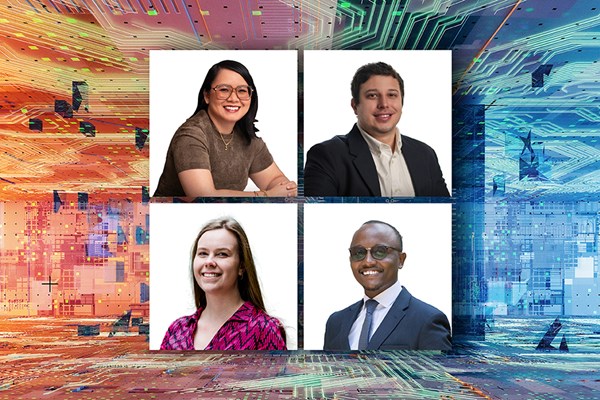Interview: how our future leaders think AI is shaping the construction industry
Artificial intelligence (AI) is one of today’s most frequently debated tools. While AI has potential to revolutionise multiple industries, the transformative opportunities it presents are simultaneously loaded with challenges around accuracy, ethics and the impact automation may have on jobs. The construction industry needs to understand the potential implications of AI and how it is likely to influence the sector, whether embraced or ignored.
We spoke to four rising stars from across our global offices, Siti Norman, Director (Singapore), Guilherme Lombardo, Senior Digital Manager (Sau Paulo, Brazil), Michaela Fiserova, Associate Director (London, UK), and Habel Mwashigadi, Project Manager (Kenya, Africa), to consider the use of AI in their respective countries and how they believe AI will impact the construction sector and wider society.

Our rising stars Siti Norman, Guilherme Lombardo, Michaela Fiserova and Habel Mwashigadi
How much is AI being used or investigated in construction schemes in your region of the world?
Siti: There has been a lot of buzz around ChatGPT in Singapore, however AI tools have been used in the construction market for the past five years. This includes a particular interest in generative AI for design optioneering, automated ruled-based 3D model checking and site safety for compliance.
We have also seen universities setting up labs for innovation and incubating ideas.
Guilherme: In Brazil, AI is being used mainly in image and document analysis to improve processes such as budgeting, construction monitoring and contract management. Some start-ups are also investigating the use of robots and drones with AI for inspections and monitoring. This is on a small scale, and mostly in the testing phase but it is a great opportunity to introduce AI to consulting.
Michaela: AI tools have been used in the UK construction market for a while even though the construction industry is one of the least digitalised industries. I’ve seen some interesting use cases recently in health and safety where AI robots are tracking sites to prevent accidents and injuries. We’ve also been trialling using machine learning for quantity take-offs and pricing.
Habel: AI has been deployed in Africa across various markets, however the uptake within the construction space still is in its early stages. The use of AI powered analytics through products such as OpenSpace has been used on fit-out and brownfield projects, as well as for reality capture on site. Matterport is also being used for virtual reality capture of spaces and design during execution on site.
Major technology players such as Microsoft and Google have also set operating bases in Africa, supporting future development in the AI space.
What do you think are the advantages and disadvantages to applying AI in construction?
Siti: The advantages of applying AI in construction will be having access to data that makes a difference. It will change the attitude we have towards collecting data and make it purposeful.
It also gives us the opportunity to level the playing field. AI can create space for diversity and inclusion, as it has the potential to allow more people to contribute to the workplace.
One of the potential disadvantages of applying AI in the workplace is the risk of exploitative business practices. AI presents large corporations with the potential to develop service offerings for clients with the potential to eliminate whole teams. What AI cannot replace, however, is the human interventions that make our lived experiences unique. AI is a great enabler, but it is not the only solution.
Habel: AI gives the construction industry vast opportunities to combat a legacy of productivity issues. Design processes have been made faster with the generative capabilities of AI through predictive design processes that introduce more feasible variations. This allows both designers and enabled designs to be optimised and executed to avoid repetitive mistakes.
Through AI-enabled analytics, the decision-making process within the construction process has also been shortened, allowing for faster and more accurate decisions to be made.
Michaela: The disadvantages of AI are more likely to be caused by an incorrect implementation rather than AI itself. This could include insufficient regulation leading to misuse, inability to remove bias from the dataset or insufficient investment in change management. It’s also important to consider the leaps in productivity and automation and the impact this will have on those who work in the industry.
What do you envisage for an AI-powered construction industry in the future? Where and how do you see it being applied, and what benefits will AI deliver?
Guilherme: I imagine that in the future AI will assist at all stages of construction, from planning and design to the maintenance of buildings. Projects designed by engineers with the best support from AI will be faster and of higher quality. Robots, 3D printers, and engineers wearing AR (augmented reality) glasses will speed up construction, while intelligent sensing systems will monitor structures. This will allow for more sustainable and safer projects.
Siti: Although AI is not a time machine, it will provide us with the ability to look through archives and find examples of best practice. AI will help with continuous learning and will also free up workers by removing redundant tasks and allowing more time to solve problems and provide better tailored solutions that focus on the needs of the client.
Habel: The possibilities are endless, but I envisage a productive industry. An industry where the design process is inclusive and interactive, and that is rich in data. It will also enable minimal waste generation as the concept of retrofitting and re-purposing of an assets is encompassed at the onset of the design.
What do you think the longer-term impacts of AI use could be on the world of work, and society more widely?
Siti: The potential impact of AI technologies such as automation and voice activation, and the shift this will have on inclusivity is profound. Imagine the doors that would open for individuals who currently face barriers to using traditional technology. This innovation doesn’t just make life easier for the average user, it revolutionises the landscape for those who have been marginalised or left out of the workforce. A world of opportunity emerges for differently abled individuals to contribute their talents in ways that were previously inaccessible to them, ushering a new era of empowerment, where technology becomes the bridge to inclusion and a catalyst for a more diverse workforce.
Guilherme: I believe that AI will bring more productivity and greater quality of life, but it will also require careful policies and continued training to manage human redundancies. It will be necessary to rethink income distribution to include both creative and technological jobs that can’t be replaced by machines.
Michaela: It’s important we are comfortable not being able to foresee all potential impacts of AI. Technology has rapidly evolved over recent decades, and nobody was able to predict where developments would lead us. The is key is the ability to adapt fast. I see AI as a positive enabler to transform working patterns that can generate time for us to solve the big challenges of today such as sustainability, inclusion and change of lifestyle habits. AI is an enabler of transformation, not the driver. It’s up to us how we embrace it to see whether the impact will be positive or negative.
Habel: It is imperative that we understand that AI, in whatever shape and form, is here to stay. If the advantages of AI come into fruition, the long-term impact will be extrapolated efficiencies across multiple markets. If deployed within ethical confines, AI has the potential to enrich human lifestyle and augment standards of living.

